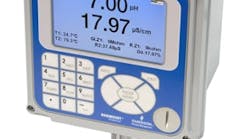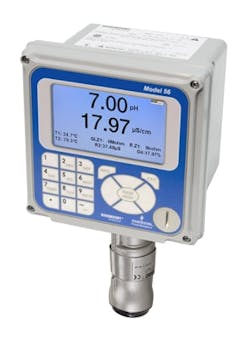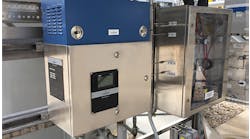Liquid analyzers have been used for years in industrial applications for pH, conductivity, oxygen, chlorine and other measurements. In recent years, it has become common practice to have line-powered multiparameter analyzers make two or more measurements; using signal cards for each desired measurement type enables a single device to meet the needs of the application. Yet, many users don’t realize that adding or changing signal cards gives these analyzers the flexibility to handle new or evolving applications — solving problems beyond their liquid measurement functions quite cost effectively and possibly reducing costs in other areas of the plant as a result.
Figure 1. Device provides capabilities for control as well as measurement.
For instance, inputting non-analytical measurements into a liquid analyzer can improve the accuracy of the main measurement. All the most common liquid analytical measurements require a temperature measurement to correct a measured value to a standard temperature. In some cases, the main sensor may lack a temperature element or may have a very slow temperature response, sometimes as long as 30 minutes. An accurate reading won’t occur until the temperature reaches equilibrium. Inputting a fast-responding temperature measurement can improve the accuracy of the main measurement — as well as its efficiency. All the plant operator has to do is add a simple temperature input.
Two common oxygen measurements, % oxygen in gas and % saturation of oxygen, depend upon the total pressure. Changes in the total pressure will cause errors in these measurements if the total pressure isn’t measured and corrections applied. Inputting a pressure measurement enables the analyzer to correct these oxygen measurements for total pressure changes. Again, the addition of a non-analytical measurement — pressure — to the multiparameter analyzer saves time and money and improves accuracy.
Non-analytical measurements also can be very useful and provide cost savings by:
• Preventing damage to the analytical sensor. Measurement of sample temperature or pressure can allow diverting sample flow if the temperature or pressure exceeds the sensor’s limits.
• Detecting loss of sample flow conditions. Measurement of flow in monitoring and data logging applications can identify when an analytical sensor is out of contact with the sample process, a situation that can lead to false readings and, thus, false alarms.
For multiparameter analyzers used for water treatment, it’s often useful to have a flow totalizing capability. This allows observing and logging the rate and total volume of water treated. A flow input signal card can accommodate a low-cost pulse flow sensor as well as any full-featured flow transmitter.
Adding Measurements
Getting readings for pressure, temperature and flow only requires a simple connection of a two-wire transmitter, without the need for an additional power supply. This saves money and reduces complexity while improving the accuracy of the analytical measurement or integrating another needed non-analytical measurement into the application.
A signal card is used for inputting 4–20-mA signals for temperature, pressure and pulse flow. Because multiparameter analyzers are line-powered (85–230 VAC, 47.5–65.0 Hz, 20 W; or 20–30 VDC, 20 W), they not only can receive a transmitter signal but also, if needed, can power the transmitter that provides the signal. All that’s required to input a transmitter signal is to connect the transmitter to the powered input of the signal board in the analyzer.
The analyzer software recognizes the presence of the analog input signal card; the only configuration required is to scale the analog input and assign a unit. Once the input is scaled, it becomes an integral measurement of the analyzer, no different than pH or any other analytical measurement. An input measurement can be applied to any of the analyzer features such as HART transmissions, data logging, and discrete and analog outputs. The increased functionality associated with the external measurement incurs only a small increase in cost.
Control Capabilities
Multivariable analyzers can do more than provide measurements. For instance, they can handle a number of traditional water treatment functions and controls, including on/off control, on/off control with delay (to allow time for mixing), interval timer (typically for sensor cleaning), and a date and time signal (sprinkler timer) for routine chemical additions. There’s also event-based relay activation, which can be based on totalized flow or the activation of another relay.
In addition, control functions include time proportional control (TPC, duty cycle), using a standard proportional-integral-derivative (PID) algorithm and one or more of the analyzer’s relays. PID control also is available using one or more of the analyzer’s analog outputs. As is the case with TPC, this relies on a standard PID algorithm; the control variable can be any analytical or input measurement.
The analyzer’s discrete and analog control capabilities also make it easily adaptable as a single station controller for applications such as skids, utilities, waste treatment and outfalls that require basic PID control but aren’t hooked up to the plant’s distributed control system. Control applications have included PID for pH control, TPC with ORP for chlorine destruction, and differential pressure input for level control. In one case, a multivariable analyzer was used to provide temporary water level control during a plant turnaround. Because the site already had the instrument installed, all it had to do was simply add a 4–20-mA signal card and configure it for level control. The instrument was quickly adapted at minimal cost. In general, the only questions that have arisen in applying the control capability of the analyzer have been whether to opt for direct or reverse control action, a common control question.
Multiparameter analyzers aren’t appropriate when you need more than simple single-loop control, e.g., multi-loop control or more sophisticated control algorithms. They also shouldn’t be used for control when the control action must be interrelated or interlocked among a number of measurements. Such situations require a programmable logic controller or another more powerful device. However, for a range of straightforward control functions that plants need every day, using the analyzer as a controller can be effective and provide cost savings.
A bad measurement due to a fault leads to bad control output whether it’s analog PID, discrete TPC, or even on/off control; the effects of a faulty control signal can cause major process problems. It’s important to set a fault value for analog outputs, so the PID control output will go to a safe value during a fault. In the case of TPC, assign a fault relay, which can be used with the TPC relay and a timer relay to provide a safe pulse output.
Multiparameter analyzers also provide data logging capability and can capture primary and secondary measurements, input values, totalized flow and analog output values, including PID output. The analyzers typically can store a month’s worth of data taken at 30-second intervals. Events, such as faults, warnings and power on, are written to an event log as they occur. The logged data and an event logger can be downloaded from the analyzer to a memory stick for further analysis or incorporation into plant records.
So, using a multiparameter analyzer for an application such as monitoring pH and totalized flow at a plant outfall ideally would involve only a monthly visit to the analyzer to download data and perform any necessary maintenance. On the other hand, operations and maintenance staffs must be aware of the quality of the measurement and control on a real-time basis, creating a need for communication with the analyzer.
Communication
A multiparameter analyzer has a number of secondary measurements associated with each main measurement. For example, a pH measurement involves not just pH but also temperature, glass impedance and reference impedance as secondary measurements. Two pH measurements would have a total of eight measurements available. No matter which digital communication protocol is being used, it’s important that all these measurements can be transmitted. In the case of HART, the older revision 5 only can handle four measurements, so it’s necessary to use the newer HART revision 7, which can transmit all eight. In the case of the outfall monitoring application, this later revision easily can accommodate all four pH related measurements as well as flow and totalized flow.
However, connecting a multiparameter analyzer to the plant control system requires accessing an input/output (I/O) port for the analyzer’s digital signal, which in the case of HART is the analog signal carrying HART. And possibly, the lack of an I/O port near the application is the reason for using the analyzer instead of the plant control system. If this is the case, running signal wire could cost as much as $1,000 or more per foot in some locations.
In such a situation, wireless communication such as Wireless HART can be a lower-cost alternative because it eliminates the need for signal wiring. Making a HART multiparameter analyzer wireless simply involves adding a wireless adapter that can access the measurements and transmit them wirelessly.
The multiparameter analyzer with a wireless adapter securely communicates with a wireless gateway that, in turn, communicates with the control system. This provides a number of ways that all the device variables pertinent to the application can be made available for data logging or alarming based on their values or status, which alerts operations and maintenance staffs of problems with the application. The analyzer with a wireless adapter also can be added to an existing wireless HART network. The cost of a wireless adapter and a wireless HART gateway may compare very favorably to running signal wire any great distance.
Beyond simply supplying live measurements and status, the gateway can link to asset management software that will provide detailed diagnostic information on the multiparameter analyzer, analytical sensors and the link between it and any transmitters used with it. In fact, if the multiparameter analyzer is used with a HART transmitter, that transmitter itself can be provided with its own wireless adapter, which makes its diagnostic information available to the asset management software. In this way, all the information on how well the application is functioning is available remotely.
Asset management software also enables configuring the multiparameter analyzer and any transmitter used with its own wireless adapter. In cases where PID or other control is used, control can be tuned remotely because tuning constants are made available to the asset management software.
Seize The Opportunity
Multiparameter analyzers clearly can do more than simply provide multiple analytical measurements. Their ability to power and input analog signals from other transmitters has made it possible to use them to easily consolidate analytical and non-analytical measurements for low-cost monitoring. The flexibility of multiparameter analyzers allows for quick adjustment of measurements by changing signal cards; the ease and simplicity of configuring the analyzers means a user can quickly adapt them to new applications. Their discrete and analog control capabilities permit the analyzers to handle single station control, not only for analytical measurements but also for virtually any measurement with an analog output. Using wireless HART and HART revision 7 provides a simple, cost-effective means to integrate monitoring and control applications using multiparameter analyzers into the plant control system.
JIM GRAY is an application manager with Emerson Process Management, Rosemount Analytical, Irvine, Calif. Email him at [email protected].


